The AMD Radeon R9 Fury X Review: Aiming For the Top
by Ryan Smith on July 2, 2015 11:15 AM ESTCompute
Shifting gears, we have our look at compute performance. As an FP64 card, the R9 Fury X only offers the bare minimum FP64 performance for a GCN product, so we won’t see anything great here. On the other hand with a theoretical FP32 performance of 8.6 TFLOPs, AMD could really clean house on our more regular FP32 workloads.
Starting us off for our look at compute is LuxMark3.0, the latest version of the official benchmark of LuxRender 2.0. LuxRender’s GPU-accelerated rendering mode is an OpenCL based ray tracer that forms a part of the larger LuxRender suite. Ray tracing has become a stronghold for GPUs in recent years as ray tracing maps well to GPU pipelines, allowing artists to render scenes much more quickly than with CPUs alone.
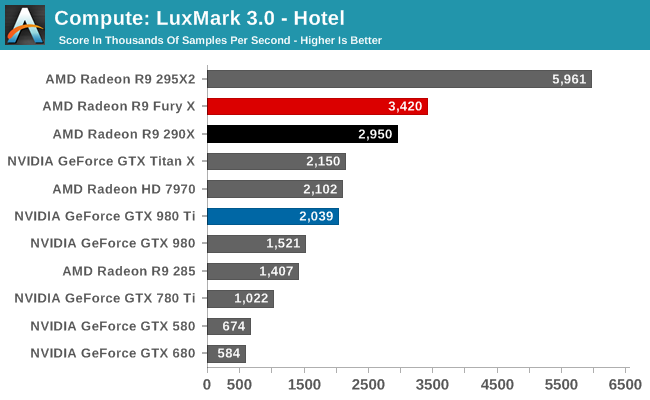
The results with LuxMark ended up being quite a bit of a surprise, and not for a good reason. Compute workloads are shader workloads, and these are workloads that should best illustrate the performance improvements of R9 Fury X over R9 290X. And yet while the R9 Fury X is the fastest single GPU AMD card, it’s only some 16% faster, a far cry from the 50%+ that it should be able to attain.
Right now I have no reason to doubt that the R9 Fury X is capable of utilizing all of its shaders. It just can’t do so very well with LuxMark. Given the fact that the R9 Fury X is first and foremost a gaming card, and OpenCL 1.x traction continues to be low, I am wondering whether we’re seeing a lack of OpenCL driver optimizations for Fiji.
For our second set of compute benchmarks we have CompuBench 1.5, the successor to CLBenchmark. CompuBench offers a wide array of different practical compute workloads, and we’ve decided to focus on face detection, optical flow modeling, and particle simulations.
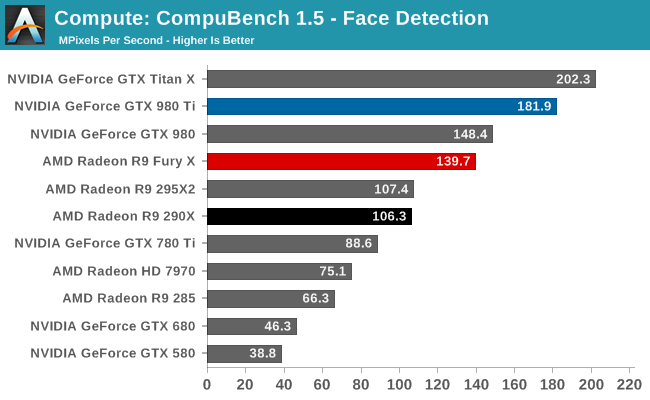
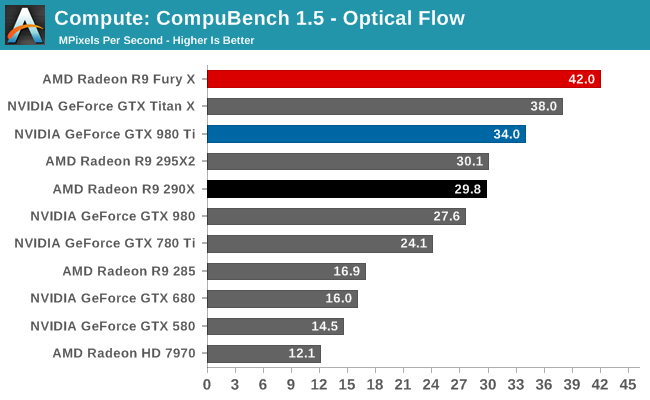

Quickly taking some of the air out of our driver theory, the R9 Fury X’s performance on CompuBench is quite a bit better, and much closer to what we’d expect given the hardware of the R9 Fury X. The Fury X only wins overall at Optical Flow, a somewhat memory-bandwidth heavy test that to no surprise favors AMD’s HBM additions, but otherwise the performance gains across all of these tests are 40-50%. Overall then the outcome over who wins is heavily test dependent, though this is nothing new.
Our 3rd compute benchmark is Sony Vegas Pro 13, an OpenGL and OpenCL video editing and authoring package. Vegas can use GPUs in a few different ways, the primary uses being to accelerate the video effects and compositing process itself, and in the video encoding step. With video encoding being increasingly offloaded to dedicated DSPs these days we’re focusing on the editing and compositing process, rendering to a low CPU overhead format (XDCAM EX). This specific test comes from Sony, and measures how long it takes to render a video.
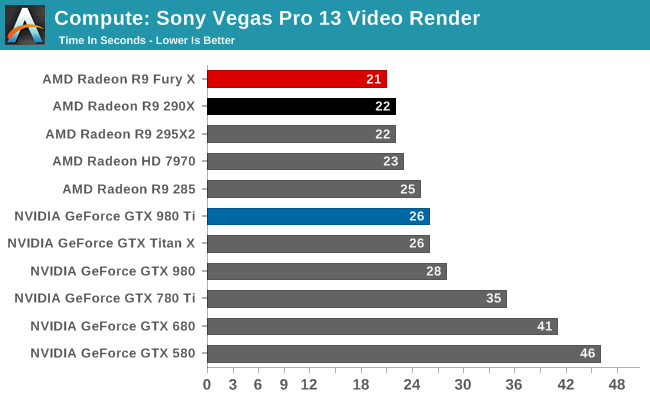
At this point Vegas is becoming increasingly CPU-bound and will be due for replacement. The Fury X none the less shaves off an additional second of rendering time, bringing it down to 21 seconds.
Moving on, our 4th compute benchmark is FAHBench, the official Folding @ Home benchmark. Folding @ Home is the popular Stanford-backed research and distributed computing initiative that has work distributed to millions of volunteer computers over the internet, each of which is responsible for a tiny slice of a protein folding simulation. FAHBench can test both single precision and double precision floating point performance, with single precision being the most useful metric for most consumer cards due to their low double precision performance. Each precision has two modes, explicit and implicit, the difference being whether water atoms are included in the simulation, which adds quite a bit of work and overhead. This is another OpenCL test, utilizing the OpenCL path for FAHCore 17.
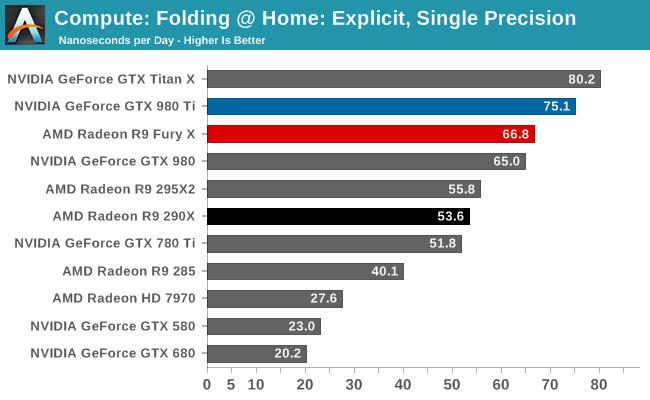

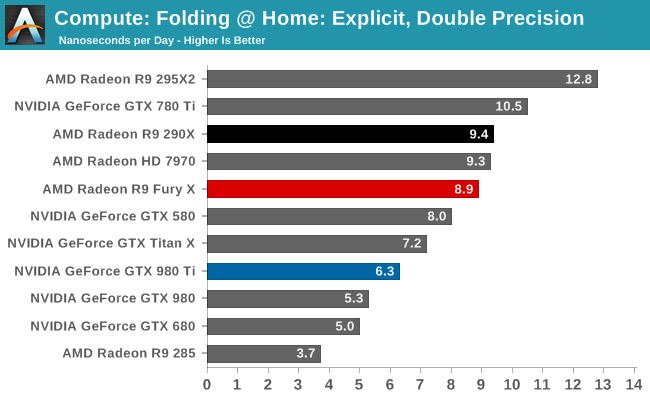
Both of the FP32 tests for FAHBench show smaller than expected performance gains given the fact that the R9 Fury X has such a significant increase in compute resources and memory bandwidth. 25% and 34% respectively are still decent gains, but they’re smaller gains than anything we saw on CompuBench. This does lend a bit more support to our theory about driver optimizations, though FAHBench has not always scaled well with compute resources to begin with.
Meanwhile FP64 performance dives as expected. With a 1/16 rate it’s not nearly as bad as the GTX 900 series, but even the Radeon HD 7970 is beating the R9 Fury X here.
Wrapping things up, our final compute benchmark is an in-house project developed by our very own Dr. Ian Cutress. SystemCompute is our first C++ AMP benchmark, utilizing Microsoft’s simple C++ extensions to allow the easy use of GPU computing in C++ programs. SystemCompute in turn is a collection of benchmarks for several different fundamental compute algorithms, with the final score represented in points. DirectCompute is the compute backend for C++ AMP on Windows, so this forms our other DirectCompute test.
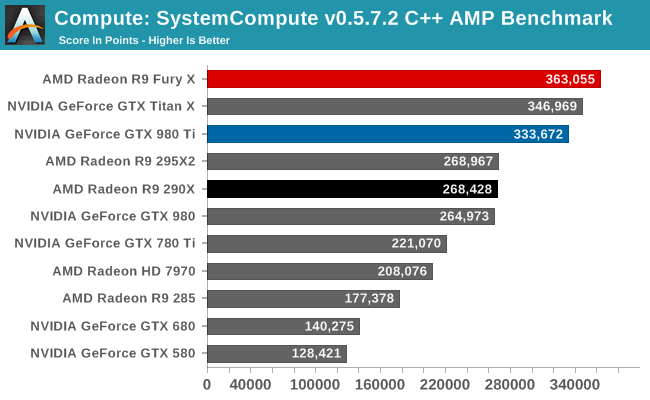
Our C++ AMP benchmark is another case of decent, though not amazing, GPU compute performance gains. The R9 Fury X picks up 35% over the R9 290X. And in fact this is enough to vault it over NVIDIA’s cards to retake the top spot here, though not by a great amount.










458 Comments
View All Comments
chizow - Sunday, July 5, 2015 - link
@piiman - I guess we'll see soon enough, I'm confident it won't make any difference given GPU prices have gone up and up anyways. If anything we may see price stabilization as we've seen in the CPU industry.medi03 - Sunday, July 5, 2015 - link
Another portion of bulshit from nVidia troll.AMD never ever had more than 25% of CPU share. Doom to Intel, my ass.
Even in Prescott times Intell was selling more CPUs and for higher price.
chizow - Monday, July 6, 2015 - link
@medi03 AMD was up to 30% a few times and they did certainly have performance leadership at the time of K8 but of course they wanted to charge anyone for the privilege. Higher price? No, $450 for entry level Athlon 64, much more than what they charged in the past and certainly much more than Intel was charging at the time going up to $1500 on the high end with their FX chips.Samus - Monday, July 6, 2015 - link
Best interest? Broken up for scraps? You do realize how important AMD is to people who are Intel\NVidia fans right?Without AMD, Intel and NVidia are unchallenged, and we'll be back to paying $250 for a low-end video card and $300 for a mid-range CPU. There would be no GTX 750's or Pentium G3258's in the <$100 tier.
chizow - Monday, July 6, 2015 - link
@Samus, they're irrelevant in the CPU market and have been for years, and yet amazingly, prices are as low as ever since Intel began dominating AMD in performance when they launched Core 2. Since then I've upgraded 5x and have not paid more than $300 for a high-end Intel CPU. How does this happen without competition from AMD as you claim? Oh right, because Intel is still competing with itself and needs to provide enough improvement in order to entice me to buy another one of their products and "upgrade".The exact same thing will happen in the GPU sector, with or without AMD. Not worried at all, in fact I'm looking forward to the day a company with deep pockets buys out AMD and reinvigorates their products, I may actually have a reason to buy AMD (or whatever it is called after being bought out) again!
Iketh - Monday, July 6, 2015 - link
you overestimate the human drive... if another isn't pushing us, we will get lazy and that's not an argument... what we'll do instead to make people upgrade is release products in steps planned out much further into the future that are even smaller steps than how intel is releasing nowsilverblue - Friday, July 3, 2015 - link
I think this chart shows a better view of who was the underdog and when:http://i59.tinypic.com/5uk3e9.jpg
ATi were ahead for the 9xxx series, and that's it. Moreover, NVIDIA's chipset struggles with Intel were in 2009 and settled in early 2011, something that would've benefitted NVIDIA far more than Intel's settlement with AMD as it would've done far less damage to NVIDIA's financials over a much shorter period of time.
The lack of higher end APUs hasn't helped, nor has the issue with actually trying to get a GPU onto a CPU die in the first place. Remember that when Intel tried it with Clarkdale/Arrandale, the graphics and IMC were 45nm, sitting alongside everything else which was 32nm.
chizow - Friday, July 3, 2015 - link
I think you have to look at a bigger sample than that, riding on the 9000 series momentum, AMD was competitive for years with a near 50/50 share through the X800/X1900 series. And then G80/R600 happened and they never really recovered. There was a minor blip with Cypress vs. Fermi where AMD got close again but Nvidia quickly righted things with GF106 and GF110 (GTX 570/580).Scali - Tuesday, July 7, 2015 - link
nVidia wasn't the underdog in terms of technology. nVidia was the choice of gamers. ATi was big because they had been around since the early days of CGA and Hercules, and had lots of OEM contracts.In terms of technology and performance, ATi was always struggling to keep up with nVidia, and they didn't reach parity until the Radeon 8500/9700-era, even though nVidia was the newcomer and ATi had been active in the PC market since the mid-80s.
Frenetic Pony - Thursday, July 2, 2015 - link
Well done analysis, though the kick in the head was Bulldozer and it's utter failure. Core 2 wasn't really AMD's downfall so much as Core/Sandy Bridge, which came at the exact wrong time for the utter failure of Bulldozer. This combined with AMD's dismal failure to market its graphics card has cost them billions. Even this article calls the 290x problematic, a card that offered the same performance as the original Titan at a fraction of the price. Based on empirical data the 290/x should have been almost continuously sold until the introduction of Nvidia's Maxwell architecture.Instead people continued to buy the much less performant per dollar Nvidia cards and/or waited for "the good GPU company" to put out their new architecture. AMD's performance in marketing has been utterly appalling at the same time Nvidia's has been extremely tight. Whether that will, or even can, change next year remains to be seen.